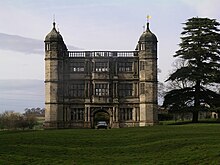Tixall Gatehouse
Tixall Gatehouse is the remains of a former manor house in the village of Tixall near Stafford in the English county of Staffordshire . The 16th century mansion called Tixall Hall , which served as a prison for Mary Queen of Scots for two weeks in 1586 , was demolished in 1927. English Heritage has listed the gatehouse, which has been preserved to this day, as a historical building of the first degree.
history
The Tixall manor belonged to the Littleton family for many years until 1507 . Then the Littleton heiress married Sir John Aston . Sir Edward Aston , the High Sheriff of Staffordshire , had the medieval manor house replaced with a new one around 1555. The gatehouse was added around 1580. It is a three-story, rectangular building whose balustraded facade is decorated with three rows of double columns. There are four octagonal corner towers that are covered with domes and decorated with weather vanes .

The Astons were later promoted to Baronets and later Lords Aston of Forfar. Walter Aston, 2nd Lord Aston of Forfar , became a Catholic rebel. After his death, it was said that he received Jesuits at Tixall Hall and held meetings there in August and September 1677, which were also attended by William Howard, 1st Viscount Stafford , and Aston's steward, Stephen Dugdale. There they would have conspired to murder King Charles II . Amid the rumors of the papist conspiracy , a contemporary witness, William Skelton , described how he had found Dugdale and the Viscount Stafford talking alone in the Small Parlor, as well as the Great Parlor (a dining room near Lord Aston's bedchamber) at Tixall Hall in September 1678. A letter from Viscount Stafford reporting a conspiracy was found in Lord Aston's study.
After the death of the 6th Lord Aston, the property fell to his sister, who married Thomas Clifford . Around 1780 Clifford had the old house replaced by a new one, but the gatehouse from the Tudor period was preserved. Many families in the area are descended from the Astons; B. the Levett family from Lichfield (and later from Wychnor Park ).
Around 1835, the Cliffords sold the Tixall estate to Earl Talbot of nearby Ingestre Hall . The mansion was demolished in 1927, leaving only the gatehouse, and the property was split up and sold in small plots in 1960. In 1968 the Landmark Trust bought the gatehouse, which is now rented out as a vacation home after restoration.
Mary Queen of Scots at Tixall Hall
Mary Queen of Scots was imprisoned at Tixall Hall for two weeks in 1586. Her prison guard, Amias Paulet , had checked in September 1585 whether the manor was suitable as a permanent seat for the Scottish queen. Paulet thought the house was suitable, but objected that it was a shame to force Walter Aston and his household of 100 people to move out, since his high position as a member of parliament and his religion were good for the region. Aston contested that the move would affect his agriculture and he would have to sell his 60 calves and plowed oxen.
On August 11, 1586, the English administration decided to respond to the Babington conspiracy . Mary Queen of Scots was on a horseback ride from Chartley Castle with Bastian Pagez , her doctor Dominique Bourgoing and others and were surprised by armed soldiers who took her to Tixall Hall to search Maria's room in Chartley Castle and take her papers .
Francis Walsingham sent an order to Paulet from Windsor Castle on September 25, 1586 to detain her at Tixall Hall, as Queen Elizabeth I wanted to send her to Fotheringhay Castle . But Paulet had brought Mary back to Chartley Castle before the new order came. When Maria left Aston Tixall Hall with Paulet and Walter, she cried and said to some poor people at the gate of the manor: "I have nothing for you, I am a beggar like you, everything has been taken from me."
Individual evidence
- ↑ Sir Robert Douglas, James Balfour Paul (Editor): The Scots Peerage . Volume I. David Douglas, Edinburgh 1904. Retrieved October 25, 2016.
- ^ Stephen Dugdale: Information of Stephen Dugdale delivered at the House of Commons, November, 1680 . London 1680. Chapter: Tryal of William Viscount Stafford for high treason . London 1681.
- ↑ John Smith: A discourse occasioned by the late conspirators dying in the denyal of their guilt: with particular reflections on the perjury of Will. Viscount Stafford . London 1681.
- ^ Charles Herbert Mayo: A Genealogical Account of the Mayo and Elton Families of the Counties of Wilts and Hereford . Privately published by Charles Whittingham and Co., London 1882. Retrieved October 25, 2016.
- ^ Tixall Gatehouse . (Details, photos, plans, etc.) Landmark Trust. ( Memento of the original from March 10, 2012 in the Internet Archive ) Info: The archive link was automatically inserted and not yet checked. Please check the original and archive link according to the instructions and then remove this notice.
- ^ John Morris (editor): Letter Book of Amias Paulet . 1874. pp. 98-102. Chapter: Calendar State Papers Scotland . Volume 8. 1914. p. 113 (only excerpts).
- ↑ John Guy: Queen of Scots: The True Story . 2005. pp. 469-480. Entry: Régis de Chantelauze (editor): Marie Stuart, son procès et son exécution: d'après le journal inédit de Bourgoing, son médecin, la correspondance d'Amyas Paulet, son geôlier et autres documents nouveaux . Plon 1876.
- ^ Calendar State Papers Scotland . Volume 8. 1914. pp. 628, 632.
swell
- Staffordshire Historical Collections . Volume 4. 1883. pp. 20-25. British History Online.
- William White: History, Gazetteer and Directory of Staffordshire . 1851. GENUKI.
Web links
Coordinates: 52 ° 48 ′ 14.8 " N , 2 ° 1 ′ 56.6" W.
